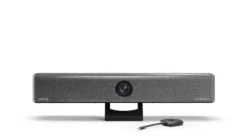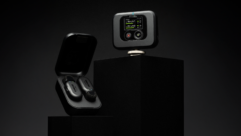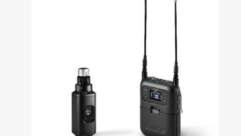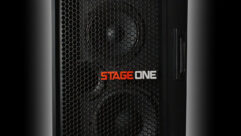
Shure ULXD24 SM58 Wireless System Review
May 13, 2013 4:22 PM,
Reviewer: John McJunkin
A feature-laden RF microphone for permanents installations.

It seems as if there are hundreds of manufacturers making wireless systems, and while that might be an exaggeration, it’s not a big one. The makers of wireless systems certainly number in the dozens, with a huge array of offerings. With that many products available, the question remains, why aren’t there more wireless systems that are developed deliberately to be friendly to contractors and integrators? I would like to see more systems with features that help contractors and integrators meet the requirements of their clients. Expanded functionality also creates opportunities for increased profitability. Clients may not even be aware of the range of additional features available to them, and contractors and integrators can offer these extended possibilities and make clients happy, despite having parted with more cash.
Shure’s ULX-D range of digital wireless systems offers many such additional capabilities. Among other things, digital audio networking is integrated right in to the system. Shure chose the Dante protocol, which is emerging as very popular, if not a standard. Clearly as time goes by, we continue to move more audio via network and less in the analog domain, so having network capability built directly into the system definitely catches my eye. In addition to routing audio via Dante, system-wide control and monitoring is also accomplished over Ethernet. The system is also compatible with Axient AXT600 Spectrum Manager, which grants sophisticated scanning and allocation of frequencies in systems with a high signal count. Control of system parameters via the AMX/Crestron protocol is another feature that will make contractors and integrators smile. Many clients will appreciate recharging rather than replacing batteries, and Shure’s optional lithium-ion battery packs can be charged quickly, with battery life displayed in hours and minutes, accurate to within 15 minutes. (How many times have you sweated battery life, not knowing exactly how long one dot out of four represents?) If you get into a pinch and have no batteries charged, standard AA batteries can be used as well.
For critical applications, the system’s frequency diversity enables “double-packing,” i.e., transmitting audio from a single speaker’s microphone with two distinct bodypacks, each set to a distinct frequency. If one weakens or fails out right, the system switches to the second frequency within milliseconds, delivering seamless audio. For high-security applications, advanced 256-bit encryption is available for use. A high-density mode is available, allowing up to 47 wireless channels to be squeezed into the space of a single 6MHz television channel (17 channels are normally available in this same range). As the available bandwidth continues to shrink, this is really important. Shure also very deliberately made the system easily scalable, with single, dual, and quad-channel receiver units available, along with a broad array of microphones and transmitters to meet the client’s requirements. One of the more remarkable features of the system is its audio resolution—24-bit/48kHz, which yields full 20Hz – 20kHz audio range, with a dynamic range in excess of 120dB.
I evaluated a ULXD4D unit with two receivers. Across its front panel is an IR port for transmitter/receiver synchronization; an LCD display; enter, exit, and scan buttons; and a rotary encoder/pushbutton for navigation. Each of the two receivers has select, sync, and up/down buttons used exclusively for audio gain. At the far right of the front panel is a power switch. The rear panel is similarly simple, with BNC antenna jacks at either end, each also with a cascade jack for connection to another receiver. At the right end, there are XLR audio outputs, each with a switch that toggles between mic and line level output. To the left of the audio connections are two network ports for delivery of audio via Dante and to facilitate system control via Ethernet. At the far left is an IEC AC power inlet.
The ULXD24 SM58 system I evaluated included two ULXD2 handheld transmitters with SM58 capsules. The lower half of the transmitter’s housing screws off to reveal the battery compartment and a menu navigation button. Above this housing are the on/off switch, IR port, and LCD display. I was very impressed with the amount of information presented by the display, including transmitter channel, frequency, lock status for both power switch and menu, the aforementioned battery runtime indicator, RF power, encryption status, and gain offset, which facilitates mixing when multiple transmitters are tuned to a single receiver channel.
Shure offers its Wireless Workbench application for both Macintosh and Windows platforms, and I downloaded and installed the version 6 beta. Without digging into the full depth of this app’s capabilities, it fundamentally provides information about all of the hardware in the system, including products from manufacturers other than Shure. It shows an inventory of all mics, in-ear monitors, and other system-oriented devices. The ULXD2 hardware scans the frequency ranges and the available channels are shown in the application. Another tab in the main display shows detailed monitoring of each device. I found RF and audio levels, frequency and channel information, transmitter overload, lock status, and offset gain, among other details. I was also able to mute each mic independently—a very handy feature. The Wireless Workbench app offers highly detailed and sophisticated monitoring and control—probably more sophisticated than most contractors will usually require, but I’d be happy to know I have some depth there if it is necessary. Beyond Shure’s application, Audinate’s Dante Controller software offers control over signal routing and configuration in a Dante network—a very powerful and welcome feature.
When I set up the system and commenced listening, I was very impressed. First, the microphone capsules are truly SM58 elements, so as long as the transmission/reception component of the system delivers the output of those capsules as it really is, it should sound just as if I grabbed a wired 58 and plugged it in with a mic cable. That is indeed the case. The digital transmission at high resolution helps to ensure that indeed we get full frequency range—20Hz to 20kHz—which is substantially wider than the capsule’s output, so the entirety of the capsule’s output appears at the receiver’s output. The proximity effect we’ve come to know and love from our SM58 is here, so speakers who know how to leverage it to their advantage will be happy with the familiarity and the capacity to move around with no cable. The transmission range published by Shure is 100 meters with line-of-sight, and of course, it tapers off out at the edge of that range, but with proper planning, it won’t cause problems.
The Shure ULXD24 SM58 wireless system sounds as close to a wired connection as any wireless system I’ve ever heard. It’s very solid in terms of RF performance and audio quality, and offers numerous features that make it very friendly to the contractor and integrator domain. This is a big step up for Shure, and it raises the bar for other manufacturers. It’s worthy of investigation as a primary system for permanent install or other applications.
PRODUCT SUMMARY
Pros: High quality, solid performing wireless system with contractor-friendly features
Cons: Comparatively more expensive
Applications: Any application that requires high-quality handheld or bodypack wireless
Price: $1,349 (street)
SPECIFICATIONS
RF carrier range: 470-932MHz, varies by region
Image rejection: >70dB, typical
Latency: <2.9 milliseconds
RF sensitivity: -98dBm at 10-5 BER
Working range: 100 meters (328ft.) line-of-sight
Audio frequency range: 20Hz – 20kHz
Audio dynamic range:
Analog output: >120dB, A-weighted
Dante digital output: 130dB (typical) A-weighted
Total harmonic distortion: <0.1% (-12dBFS input, system gain @ +10)
John McJunkin is the principal of Avalon Podcasting in Chandler, Ariz., and produces and co-hosts a top-rated morning radio talk show in Phoenix. He has consulted in the development of studios and installations and provides high-quality podcast and voice production services.










